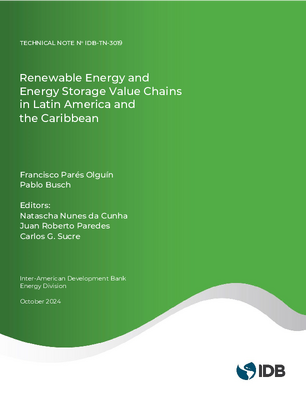Renewable Energy and Energy Storage Value Chains in Latin America and the Caribbean
Date issued
Oct 2024
Subject
Investment;
Electric Battery;
Industry;
Science and Technology;
Renewable Energy;
Wind Power;
Value Chain;
Manufacturing Industry;
Energy Transition;
Raw Material;
Solar Energy;
Mining Industry;
Energy and Mining;
Extractive Industry;
Industrial Policy;
Supply Chain;
Recycling
JEL code
Q32 - Exhaustible Resources and Economic Development;
Q42 - Alternative Energy Sources;
L72 - Mining, Extraction, and Refining: Other Nonrenewable Resources;
O13 - Agriculture • Natural Resources • Energy • Environment • Other Primary Products;
O14 - Industrialization • Manufacturing and Service Industries • Choice of Technology;
O25 - Industrial Policy
Category
Technical Notes
This document is a critical analysis of the role that Latin America and the Caribbean (LAC) can play in the global energy transition and presents recommendations to take advantage of the development opportunity that exist. The document addresses each of the five stages of the value chain - extraction, refining, manufacture, market use, and end of life - focusing on three key technologies: solar panels, wind turbines and lithium batteries. For each stage, opportunities, challenges and recommendations for LAC are defined, focusing in particular on Argentina, Bolivia, Brazil, Chile, Colombia, Ecuador, Jamaica, Mexico, Panama, Peru and Venezuela, given that these countries have significant mineral reserves, existing mining industries and/or more advanced industry that could participate in manufacturing stages of the value chain. The document is based on four recent research projects prepared by the IDB, which report on the efforts and work carried out by the Bank to promote and encourage the development of LAC in this area. The main messages of the document are summarized as follows: (1) The global energy transition presents an important economic opportunity for the development of LAC, while the production of these technologies contributes to the global fight against climate change. (2) LAC has a unique advantage in concentrating the majority of critical minerals worldwide at competitive extraction costs and to capture greater benefits in the value chain, it must exploit and expand its comparative advantages: mineral reserves, qualified labor, strategic positioning as a commercial ally of the United States and Europe, and access to port infrastructure for exports. (3) Mining extraction requires achieving and maintaining a social license to operate, so industry must go beyond national legislation on environmental and social issues. (4) Strategic alliances between countries in the region are key to compete globally in more complex stages of the value chain. (5) For the end of life of clean energy technologies, the absence of a comprehensive regulatory framework generates deficiencies in the valorization of the resource, lack of private investment, and encourages informality.
NO



